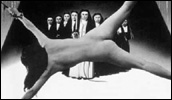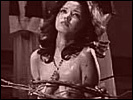School of the Holy Beast
- Year
- 1974
- Original title
- Seiju Gakuen
- Japanese title
- 聖獣学園
- Director
- Cast
- Running time
- 91 minutes
- Published
- 3 May 2006



by Jasper Sharp
Released in the early 1970s, Ken Russell's The Devils unleashed a relentless wave of sin and apostasy across European cinema screens, leaving in its wake a rapidly proliferating trail of imitators that would later become collectively termed as "nunsploitation". So significant a feature of the lower end of the theatrical market was this briefly-existing cycle that reams of pages have been written on the subject, including one encyclopaedic tome devoted to it: AntiCristo - The Bible of Nasty Nun Sinema and Culture, by Steve Fentone. Most amazing perhaps is how the winds of the international movie trade managed to fan the flames not only across the boundaries of Christian countries throughout Western Europe - in their time the industries of France, Italy, Germany, and Britain all had a pop at making at least one naughty nun movie - but across the entire breadth of the Asian continent where amazingly it spread to the comparatively secular cultural climate of Japan.
Films about Buddhist nuns (ama) are one thing, but the number of softcore fetish flicks featuring those of the Catholic variety (the shudojo, or Catholic nun) produced by Japan's major studios during the subgenre's heyday in the 1970s is pretty phenomenal when you think about it. Nikkatsu were probably the most active in the field. In 1976, the studio even managed to coax Runa Takamura, one of the former "half" chanteuses from novelty pop act Golden Half beneath the wimple for Masaru Konuma's Catholic Nun Runa's Confession (Shudojo Runa no Kokuhaku), shortly after she'd already bared her soul (and a darn site more) in her rags-to-riches kiss-and-tell story Runa's Confession: The Men Who Flocked Around Me (Runa no Kokuhaku: Watashi ni Muragatta Otoko-tachi). Japan's top bondage novelist Oniroku Dan set at least one of his vicious tales in the convent, with Catholic Nun Rope Hell (Shudojo Nawa Jigoku, 1984), and who could ever forget Koyu Ohara's Wet Rope Confession (Shudojo Nure Nawa Zange, 1979), featuring a deliciously over-the-top climax involving an altar and a fluffy sheep costume? But the mother superior of all Nipponese nudie nun extravaganzas, the one which established the template for all of these successors, came from Toei in the form of Norifumi Suzuki's legendary School of the Holy Beast.
The story opens with the beautiful Maya (Takigawa) embarking on one final night of sensuous pleasure in a colourful montage accompanying the opening credits, advancing from a Shinjuku shopping spree to riding pillion on the motorbike of a virile young hunk, who after treating her to turquoise cocktails in a chichi lounge bar and providing her with her one last night of earthly paradise, introduces himself as Kenta (Tani). Alas, the liaison is not set to last, as Maya reveals her pledge to enter that place "where women aren't women", revealed in the following atmospheric shots of the morning mist rising across a set of haystacks, as the citadel of anguish and repression in which the customary parade of perversions are to unfold: St Clore's Convent.
This cloistered world is a veritable furnace of subjugated carnal desires and broken vows. Maya is kept awake on her first night by her fellow sisters' topless self-flagellations as they attempt to rid herself of all ungodly thoughts. Later, two of the initiates seek Sapphic release in the hothouse, ornately framed by the vibrant heads of the surrounding flowers, while another pair, after being discovered greedily gorging themselves on fish sausages, are forced to engage in a topless whip fight as penance. Maya soon finds herself falling under suspicion from the other nuns as an increasing number of such violations fall under the beady eye of the Mother Superior. Father Kakinuma (Fumio Watanabe) is called in to re-establish order in the Order, but with his wild staring eyes and Rasputin-like mane of hair, it is not long before he too reveals his less than evangelical side. Fortunately Maya manages to find a soul mate in the form of another of the convent's more subversive elements, Sister Ishida (Yamauchi), but her fun as a nun merely masks her true motives for being there, as behind the convent walls there lurks a deeper secret regarding Maya's own less-than-immaculate conception.
Toei's conversion to sex film production during the decade when the industry was really ailing was never quite so wholesale as Nikkatsu. The erotic films the company did produce, however, were bigger, bolder, and more lavishly mounted, though in terms of their eroticism, the nude scenes were usually briefer, milder and more vicious than sensuous. These were films in which sex was merely a part of the exploitation, never quite the whole deal.
Norifumi Suzuki had been working as an assistant director at Toei since the late 1950s, but really came into his own when Teruo Ishii started to steer the company's output further towards the sex and sadism market with his Joys of Torture series. Throughout the 70s, Suzuki was responsible for such memorable titles as Hot Spring Soap Geisha (Onsen Suppon Geisha, 1972), The Erotic Shogun and his Twenty-One Prostitutes (Ero Shogun to Nijuichi-nin no Aisho, 1972), Sex and Fury (Furyo Ane Goten: Ino no Shika Ocho, 1973), and Terrifying Girls' High School: Lynch Law Classroom (Kyofu Joshi Koko: Boko Rinchi Kyoshitsu, 1973), though his most important contribution in Japan is considered to be the ten titles in the Truck Guy (Torakku Yaro) series. With his poetic use of colour and composition, Suzuki was by far the most aesthetically-gifted of Toei's in-house sexploitationers, manifesting an ability in films such as Star of David: Beautiful Girl Hunter (Dabide no Hoshi: Bishojo-gari, 1979) to make even the ugliest scenes of torture look beautiful.
"Dario Argento meets the Marquis de Sade" the DVD cover boldly exclaims, and though Argento's particular acquaintance was probably formed some years before School of the Holy Beast was even a transient blip in its director's mind, one can sort of see where the quote is coming from. The women-only world of St Clore's is a labyrinth of primary colours and secretive whispered voices in dark corridors, though interestingly it predates not only Suspiria, but the main glut of European nun movies by a couple of years. To label Suzuki an artist might be stretching the point a little, but certainly the scene in which Maya is disciplined after being bound in thorns and given a slow-motion thrashing with rose bush branches to form a whirlwind of petals and cascading hair is staged with a technical mastery and inventiveness that unfortunately never quite stretches to the script.
And there's the rub. One can say what one will about the similar works in the genre of Ken Russell, Jess Franco, and Walerian Borowczyk, but at least they introduced a modicum of social context to proceedings, or at the very least, they were produced in territories where religion was engrained within the constitution and thus sexy swipes at catholicism had a degree of political significance to them. Japan is a country in which catholics make up a historically-persecuted minority numbering under 2 million and the state religion of Shinto was banned by the occupation forces after the war. In other words, the fantasies of torture and lesbianism staged in these fictional neverlands where every anonymous dark robe masks a quivering torrent of repressed yearning and desire to be reigned in at the hands of a higher authority, really represents as conservative a fantasy as one will find in any other pink or Roman Porno film, and such scenes as the naked communion and a deluge of urine unleashed over an effigy of Christ are probably too trite to be viewed as truly blasphemous. One interesting element to the plot is however introduced in the images of the atomic devastation that levelled Nagasaki and left Father Kakinuma scarred from birth: Nagasaki historically served as the main enclave of catholicism in Japan during the Edo period, in which it was banned by the Tokugawa shogunate.
If all this sounds a little censorious, then it should be said that if you are looking for a good blood-and-tits movie suitable for a Friday night in with a six-pack and a box of Kleenex, then School of the Holy Beast is a pretty safe bet. It counts among the most technically adroit entries the genre has to offer. For me however, no one has done a better job in conjuring up a suitably perfervid air of eroticism and sexual hysteria in an exotic convent setting than Michael Powell did with Black Narcissus, way back in 1947 before the nunsploitation genre mushroomed, and all without revealing so much as a bare ankle. Powell's film is one of the finest exemplars of the potential synergy of form and content the cinema has to offer. School of the Holy Beast instead represents an efficient exploitation piece, an example of Suzuki's unquestionable visual prowess and a bizarre cross-cultural curio. Perhaps its main actress Yumi Takigawa, who has subsequently gone on from her demeaning debut to forge a successful career that includes numerous appearances in movies and on stage and TV, puts the film in its proper perspective in the revelatory and invaluable extras that grace this Cult Epic DVD, when she questions why anyone, out of all the genuinely good movies she appeared in, would want to release this film overseas. It won't take much of a genius to guess why.